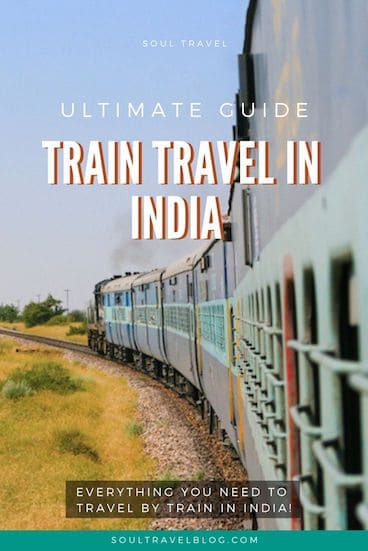Traveling by train in India is undoubtedly one of the most incredible ways to explore the subcontinent. There’s something truly special about gazing out of the window with a steaming cup of chai, soaking in the vibrant tapestry of life that unfolds outside. However, the Indian railway system is often perceived as intricate and confusing. Fear not, as we’re here to guide you through everything you need to know to maximize your train travel experience in India!
This post contains compensated affiliate links. Please check our disclosure for more information. Thank you for supporting Soul Travel!
Mastering Indian Train Travel for Foreign Visitors
I firmly believe that you haven’t truly experienced India until you’ve taken a long journey on the Indian Railways. The best views of this beautiful country come from a sleeper coach of an overnight train, where you can watch the breathtaking landscapes roll by while making new friends along the way.
Few experiences can match the joy of sitting by a window, savoring masala chai, and witnessing the diverse landscapes of India shift and blend before your eyes. Imagine standing by a train doorway at dawn after an overnight journey, with a refreshing breeze brushing against your face.
Traveling by train in India is generally safe, efficient, and comfortable (depending on your chosen class—more on that below!). It’s my favorite way to navigate this vast country. Don’t miss checking out our recommended must-take train journeys in India!
The Indian Railways is the third-largest employer globally, transporting 25 million passengers daily, and is home to the world’s longest railway platform, among other fascinating facts. Experiencing travel on Indian Railways should be on everyone’s travel itinerary in India.
However, it’s essential to understand that train travel in India isn’t as simple as just showing up. While this is changing, particularly for tourists, effective planning can significantly enhance your railway journey.
With some perseverance, you’ll find that the time and effort invested in planning your Indian train travels will be worthwhile. Many Indians rely on train travel as their primary mode of transportation, and the railways are often referred to as India’s lifeline. Considering that a population of 1.2 billion people depend on it, it’s understandable that the ticketing system can be somewhat intricate.
During my seven years of visiting and living in India, I’ve learned a great deal about traveling by Indian Railways—mostly through trial and error—so much so that locals often approach me at station platforms for directions! I’m excited to share these insights with you in this post, as well as discuss how train travel in India has evolved after Covid-19.
Planning Your Train Travel in India
The first step in planning your trip to India is establishing a rough itinerary.
This doesn’t mean you need to book every hotel or accommodation in advance, but having a clear idea of your desired destinations and the duration of your stay in each location will guide you in determining the specific dates for your Indian Railways tickets.
You may need to adjust your itinerary based on train availability or the connectivity of various locations by train (for instance, while Jaipur and Udaipur are well-connected, there are no direct trains from Udaipur to Jodhpur).
The key takeaway is to book your train tickets as soon as possible. Tickets become available for sale 120 days in advance, and ideally, you should aim to book your tickets 3-4 months ahead, particularly around busy holidays such as Christmas, New Year, Diwali, etc.
Keep in mind that not all trains run every day, and some express trains operate only on certain days of the week. When researching train options, you might encounter information similar to what’s presented below:

This chart illustrates the various trains running from Varanasi to Delhi, including the days of the week they operate (indicated by letters), the duration of the journey, and the available classes. If you want to investigate train options between cities, a quick Google search will reveal multiple websites containing this information, such as indiarailinfo.com.
Types of Trains in India
There are numerous types of trains in India, even for long distances, but it’s crucial to understand that not all trains are created equal. Some trains travel at twice the speed of others, stopping at a fraction of the stations, meaning that the same journey between two cities can range from five to ten hours depending on your choice of train.
Here are some of the primary types of trains you may encounter during your travels in India:
Overnight Trains:
- Rajdhani Express – Considered the premier express train (more like a Volkswagen than a Rolls Royce), these are the fastest and most dependable intercity express trains, connecting Delhi with various state capitals, and they’re ideal for quick and comfortable travel from Delhi to Mumbai or Delhi to Kolkata (and vice versa). Rajdhanis have prioritized track access, and meals are included. While they are entirely air-conditioned, don’t expect extravagant interiors; they look similar to other Indian Railways train coaches. This is also the priciest option, but I recommend it.
- Garib Rath – Recognizable by their olive green and mustard yellow exteriors, the Garib Rath trains are all-economy air-conditioned express trains designed to provide affordable air-conditioned travel. They operate 1-2 times a week on various routes, including one from Mumbai to Kerala (which I’ve traveled and found very comfortable). Recommended.
- Duronto Express – “Duronto” means non-stop in Bengali; these trains were introduced in 2009 as India’s first step towards high-speed rail. They were designed to provide point-to-point services without halting in between (though some now do stop). They’re generally a great choice for long-distance trips. Recommended.
- SuperFast Express – This is likely the type of train you’ll use most for intercity or town travel. These can be entirely air-conditioned (referred to as AC SuperFast) or a combination of Sleeper and AC classes (SuperFast). These train services are relatively quick and a good way to travel. Recommended.
- Express – Slightly less efficient than SuperFast Expresses, “Express” is a misnomer in many cases as these trains tend to stop more frequently and take longer to complete their journeys. While generally okay, these trains may be your only choice for less popular routes and are prone to delays compared to the trains mentioned above.
- Mail Trains / Passenger – The slowest category of trains, stopping at numerous stations, taking longer, and frequently facing delays. Only book these if there are no other viable options.
Daytime Trains:
- Tejas Express – A relatively new player in train travel, the Tejas Express trains represent India’s latest high-speed offerings, featuring modern and fully air-conditioned carriages with automatic doors and TVs in Executive AC class. While a unique feature in Indian train travel, it’s not recommended for those who prefer to sit by an open window or door. Due to their higher fare, these trains often have available seats even when others are fully booked.
- Shatabdi Express – These daytime express trains only have seating (unlike overnight trains which offer sleeper berths) and cover popular short routes like Delhi to Agra, Amritsar, and Jaipur. Shatabdi trains typically run on time and come highly recommended as they are fully AC.
- Jan Shatabdi – Similar to Shatabdi trains, but includes non-AC chair car class, making them slightly slower and more affordable. Recommended.
- Local Trains – A variety of local trains from suburban services in Mumbai and Kolkata to state-local trains run between towns, often providing only “General” unreserved seating. They can get crowded in cities, so unless you want a noteworthy experience, I’d suggest avoiding these unless necessary!
For the quickest travel time, research the fastest train for your route. Typically, SuperFast trains sell out quickly, but securing a Rajdhani ticket usually isn’t an issue, though it’s around 30% costlier than SuperFast for comparable routes.
Bear in mind that some trains are notorious for being late. I was once warned about a specific train that ended up running 11 hours late—yes, you heard that right! So now, I’m a proud member of the unofficial Indian train geek club; I check each train’s average punctuality score before booking. Websites like Railyatri.in provide an “on-time score” that can be very helpful!
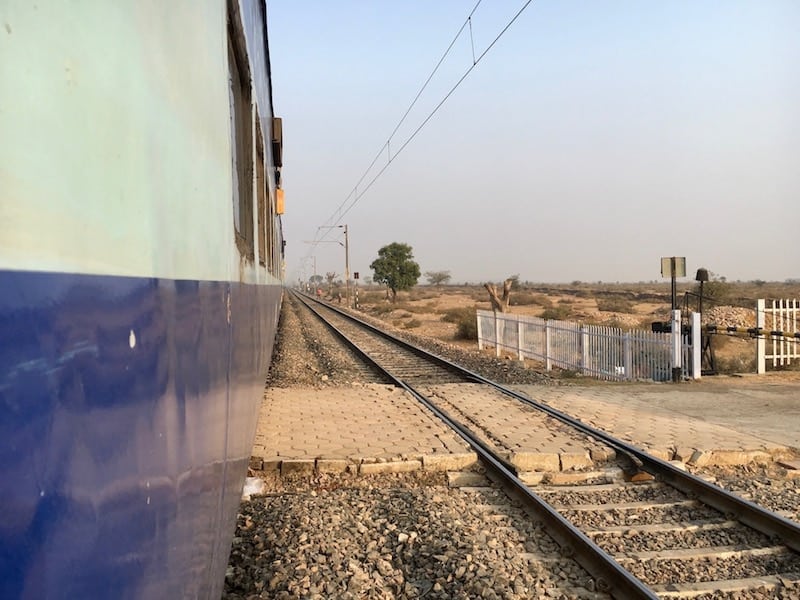
How to Book Indian Railways Train Tickets
There are several convenient ways to book your Indian train tickets. Here are a few of the best options:
Booking Indian Train Tickets From Abroad
Booking train tickets from abroad has often been challenging (and at times impossible). Common hurdles include the lack of an Indian phone number, foreign credit cards being rejected, and limited access to the foreign tourist quota. Thankfully, times are changing, and it’s now simpler than ever to secure your Indian train tickets before setting foot in the country!
Option #1 – The hassle-free way with Raj from Train Ticket Please
I used to enjoy booking my train tickets through my IRCTC account, but upon returning to India in October 2021 after Covid, I found I could no longer use my UK bank cards to make purchases. Many foreign travelers have encountered the same issue, experiencing numerous rejections when attempting to use non-Indian bank cards.
Luckily, my lifesaver Raj from Train Ticket Please came to my rescue by booking all my train tickets along with arranging ground transport, domestic flights, drivers, and guides. Raj assists with train bookings across India for a nominal service fee, saving you from hours—or even days—of frustration in navigating the Indian Railways website. It’s just that simple!
For an easy and hassle-free option, I highly recommend reaching out to him. You can contact him via WhatsApp at +91 89621 29008 or email him at trainticketplease@gmail.com mentioning ‘SOUL TRAVEL’.
Option #2 – Self-booking with 12Go.Asia
12Go.Asia is one of the leading platforms for booking transportation throughout Asia and is among the few international websites that allow Indian train bookings without requiring an IRCTC account. This makes it the fastest and easiest way to book trains in India, especially if you’re in the country for just a short time or planning only a couple of train journeys. While they may not have every single journey available yet, they do cover most of the routes typically taken by overseas visitors traveling between major cities.
Search and Book Indian Trains on 12Go here!
How to utilize 12Go.Asia for train bookings:
- Conduct a search on railyatri.in or indiarailinfo.com to view the available trains connecting your desired destinations.
- Take note of the train number and the specific departure and arrival stations—most cities feature multiple rail stations, so it’s crucial to enter the correct ones to get accurate train results.
- When booking, you can indicate your preference for upper or lower berths, along with selecting from the available classes—refer to our recommendations below for advice on what to book.
- Enter your details and pay using an international credit card. Bookings are processed on a request basis, meaning they aren’t confirmed until you receive formal approval from 12Go.Asia. You can also express if you’re flexible about traveling a day before or after your original date. Search for train trips in India now!
Search & Book Popular Train Journeys in India on 12Go
Option #3 – Create an IRCTC Account & (try to) Book Directly
This option comes with some risks if you lack access to an Indian bank or credit card—you may go through the entire booking process only to discover that your payment isn’t accepted. If you’re uncertain, I recommend utilizing one of the previous two options instead.
As of 2022, Cleartrip no longer offers the option to book trains via IRCTC accounts (a previous workaround).
This was once the standard method of booking train tickets, but it’s unlikely to succeed with foreign cards now, unless you’re fortunate. It requires a significant time investment with limited prospects for success, so I’d advise you to explore alternative options, especially just for a few train journeys. However, if you’re set on this path and know Indian friends willing to let you use their payment methods, you can proceed as follows:
Step 1: Register for an IRCTC Account.
The first step is to create an IRCTC account, which stands for Indian Railways Catering & Tourism Corporation, and oversees all railways in India. As of November 2017, you can register for an IRCTC account using a foreign mobile number (be sure to include your country code). However, the OTP (One Time Passcode) sent via SMS for account validation doesn’t always reach international numbers. If that happens, your best alternatives are to book through 12Go.Asia or email Raj at trainticketplease@gmail.com quoting “Soul Travel.”
With your foreigner account, you can also book tickets under the Foreigner Tourist Quota (more details below), but note that this quota is only available for 1AC and 2AC classes. Keep your ID and password safe as you’ll need them each time you make a booking!
You’re allowed a maximum of six single journey bookings per month with your IRCTC account. For any additional bookings beyond that limit, you’ll have to use an agent or purchase tickets at the station.
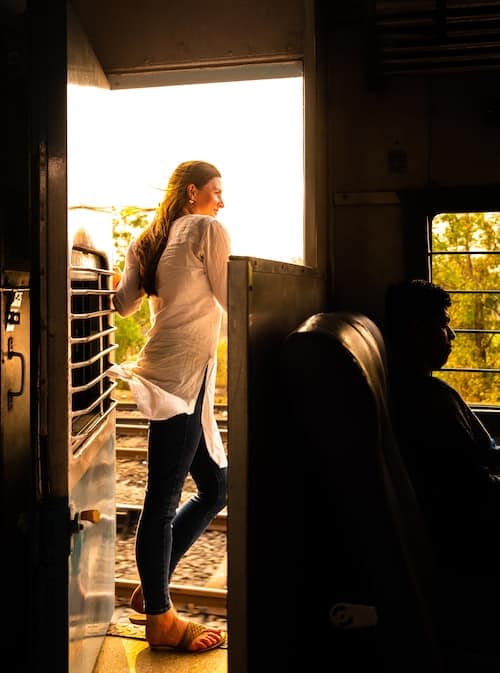
Step 2: Booking Tickets with your IRCTC Account on the IRCTC Website
Once your IRCTC account is validated, you can log in, select your train, class of travel, and preferred berth (upper/middle/lower—keep in mind you’re not guaranteed this). Log in, search for trains between your selected destinations, and preferred travel class (searching first for options is advisable to enter the precise departure and arrival stations).
Train reservations open up 120 days prior to departure. Many trains sell out weeks or even months in advance, so having your account set up early can significantly help. If there’s still availability, simply book a confirmed ticket, noting your booking number (known as PNR) and you’re good to go! If not, continue reading…
Step 3: Important Considerations When Booking Tickets Yourself via IRCTC
While searching for trains, you may encounter terms like “RAC,” “Waitlist,” and “Available.” Here’s what they indicate:

Available – Clearly means you can book a ticket with a guaranteed seat. Congratulations!
RAC –Reserved Against Cancellation. Indian Railways understands that not all ticket holders show up, hence, they “overbook” by issuing RAC tickets (similar to airlines).
With an RAC ticket, you can board the train. However, you aren’t guaranteed a specific seat/berth number at the time of booking and may have to share a berth if all ticket holders show up. Reservations are usually assigned one day before or up to four hours before the train departs, and most RAC passengers typically receive their berths. While there have been some instances where train capacity necessitated that RAC passengers remain seated for long journeys, this is unusual, and generally, it’s safe to assume you’ll secure a berth.
You should board the corresponding class of travel you selected, meaning if you booked an AC3 ticket as an RAC holder, you should board an AC3 coach. I’d recommend booking an RAC for more popular classes like AC3, as these tend to have more availability compared to first class. The number next to your RAC status (e.g., RAC 23) indicates how many people are ahead of you—naturally, the lower the number, the better your chances.
WL or Waitlist –This indicates that your train has officially closed to further guaranteed bookings. Once the general quota and all RAC tickets are sold out, the train moves on to Waitlist status. While you can book a Waitlist ticket, this means your spot on the train isn’t confirmed, and you cannot (officially) board a train with a Waitlist ticket.
Make sure to look out for our suggestions on what to do if you receive a Waitlist ticket below!
Pin this for Later!
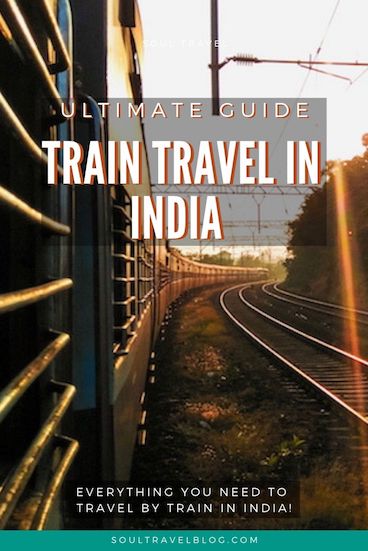
Option #3 – Engage a Local Travel Agent
While I vouch for Raj at Train Ticket Please (contact at trainticketplease@gmail.com, include “Soul Travel”), feel free to reach out to other agents you might meet during your travels—through your accommodations or guides in tourist hot spots. Agents usually charge a small fee for booking tickets.
TIP: If you opt for travel agency services in tourist areas, prior to visiting, make sure to check prices and train availability on IRCTC to gauge accurate pricing and availability. Though it’s common to pay a nominal fee (around 100 INR) for such services, be cautious of agents raising ticket prices or persuading you to book first class tickets when more economical options are available.
It’s worth noting that some agents tend to assert that specific trains are fully booked or only have first-class tickets remaining to augment their profits, which is another reason why I support using Raj at Train Ticket Please (contact above), 12Go.Asia, or any agent whom you know and trust.
Option #4 – Purchase Your Ticket at a Railway Station in India
Once you’re in India, you can visit any railway station to book tickets in person (cash payments only).
Most railway stations have English speakers available (at smaller stations, ask for the station manager), and larger stations often have dedicated ticket windows for foreign travelers. Moreover, there’s a foreigner quota that’s accessible only for in-person bookings (although some is also available through IRCTC provided you’ve registered with a foreign mobile number). Aim to book your tickets at your earliest convenience, as trains tend to fill quickly. Be wary of anyone directing you away from the ticket office and towards their travel agency (New Delhi is notorious for this!).
Logistics of Train Travel in India
Congratulations on booking your tickets! You’re halfway there 😉
Now, let’s discuss how to ensure you actually board your train.
To arrive at the correct place on the right train, you’ll need: your train number, compartment number, and berth number.
Example: 13015 (Train), B3 (Coach / “Bogie”), 23 (Berth).
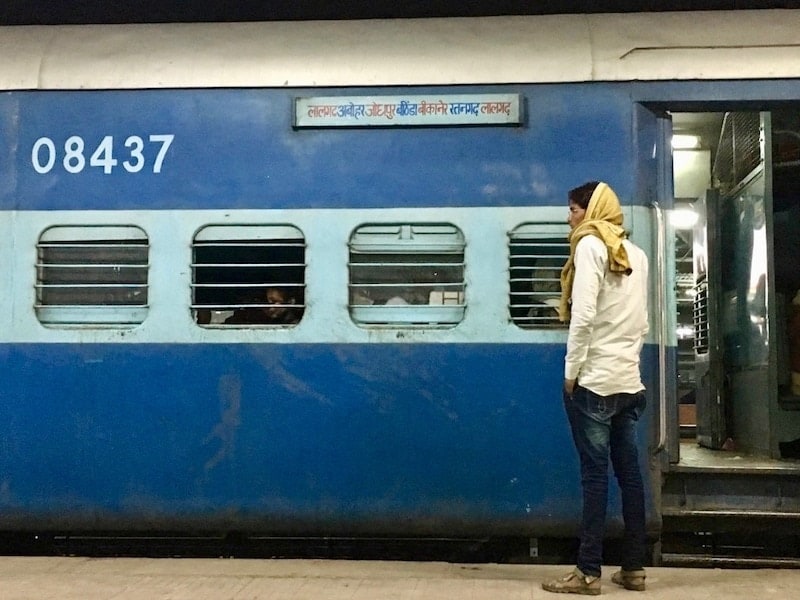
Locating Your Platform
Indian railway stations vary significantly in terms of facilities—some have clear signage while others offer little to none. If you’re boarding your train at the starting station, you should have ample time. However, if you’re getting on at an intermediate station, be sure to be in the correct location, as trains are quite long and often only stop for 2 minutes.
Make a note of your Train Number (5 digits, e.g., 13015), as some stations will display trains by their numbers rather than destinations. If there’s no display board showing train departures (usually found in the main station entrance or waiting area), you can always ask the station manager or another railway official. Porters (who wear red shirts) can also be reliable sources of information — you might even want to hire one to help with your bags and take you to the right platform.
Finding Your Coach on the Train
Once you find your platform, it’s crucial to know where to stand. THIS IS EXTREMELY IMPORTANT because Indian trains are very LONG and you need to position yourself correctly. On the platform, there will typically be numbers posted (like “10,” “11,” etc.) indicating where different coaches will stop. For instance, Coach B2 may stop at location 10, B3 at location 11, etc. In Northern India, electronic indicators with red lights often indicate which coaches will halt where. However, in Southern India, only signs with numbers are usually present, so you’ll need to determine where your coach will stop:
- Listen for announcements in Hindi and English.
- Consult a station official.
- Utilize an app or the internet to check the train composition—search for your train number along with “train composition” (or reference indiarailinfo.com). You should find a layout demonstrating where your coach will stop. Most railway stations in India now offer free, high-speed Wi-Fi thanks to Google!
- If all else fails, stand in the middle of the platform (not at either end) and prepare to sprint as the train approaches! Each coach post has a sign with the coach number (e.g., A1, B2), plus you can differentiate AC from non-AC coaches by the window seals.
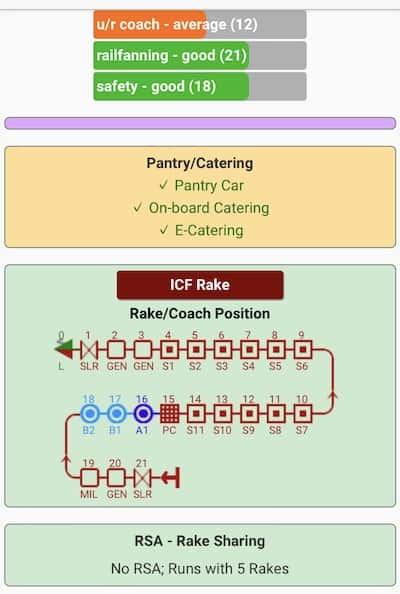
Your Seat + Coach Information
If you booked a confirmed ticket, your ticket will indicate your designated seat and coach. It will specify your coach (called a “bogie” in Indian English; for example, A1, B2, S1) and your seat/berth number (for example, 56).
Remember that the reservation charts are finalized only 4 hours before the train departs from its origin.
If you received a waitlist ticket that later confirms, two ways can help you find your seat and coach number. The easiest option is to use an app (like “Confirmtkt”) where you input your “PNR” (your ticket number), and it will return your ticket status, along with your coach and seat/berth number.
You can also send a text message from your mobile number to 139 with just your PNR, and you will receive an auto-reply detailing your coach and berth/seat number. Since this information can change up to 4 hours before departure, the ideal time to confirm is within that timeframe. You should receive a response that looks something like the following, which indicates your coach and seat/berth number.
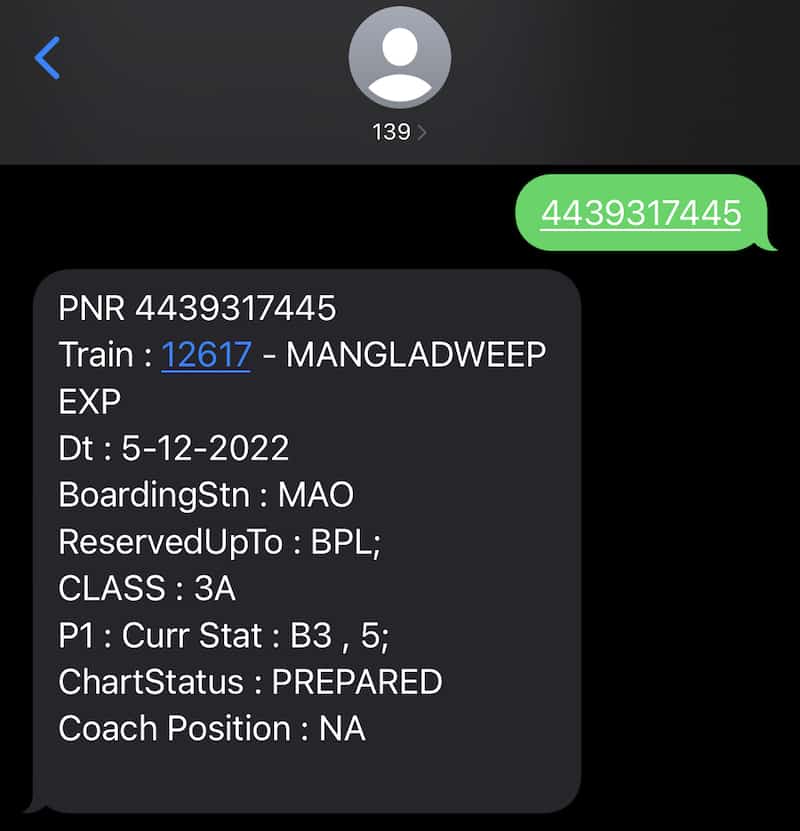
Travel Classes on Indian Trains
Indian train travel is well-known for its diverse classes, totaling nine. Fortunately, you won’t encounter all nine classes on any single train. The main options typically include First Class / 1AC, 2AC (Two-tier AC), 3AC (Three-tier AC), and Sleeper (Non-AC). Classes like 2nd (non-AC chair car) or General Class are not recommended for long journeys, as they tend to be quite basic. The Shatabdi Express trains also offer Chair Cars (CC – Air Conditioned) and Executive Chair Cars (EC – First Class Air Conditioned).
The main distinctions among the Air Conditioned Sleeper Classes (these can differ by train—hence my insights) are as follows:
First AC (1AC) provides a locking compartment shared with two or four passengers, though you won’t have the option to choose. Bedding is slightly thicker, but other than the locked door, the experience isn’t significantly different from 2AC and 3AC—shared toilets and washbasins located at the end of each coach. This isn’t particularly luxurious and is priced at roughly double that of 2AC. My sole experience in First wasn’t great, mostly due to the presence of snorers (you can read about it here).
On some special Rajdhani Express trains, meals are included. However, this can be a good choice if you’ve found your waitlist options in other classes overly long and need to make the journey. First Class is also typically reserved for Indian Ministers and other VIPs, so who knows—perhaps you’ll meet someone influential!
2AC / Two-tier AC (Recommended): This open-plan configured coach features pairs of bunks opposite each other, along with an additional two side-facing bunks along the sides of the coach. The key advantage of 2AC is the reduced height of the upper bunk (just two bunks high, compared to three in 3AC), which makes it more manageable. Each bay has curtains for added privacy. Bedding (comprising a sheet, blanket, and pillow) is included. Toilets are located at the ends of each coach.
Tip: My favorite bunk in 2AC is the side upper, providing excellent privacy!
3AC / Three-tier AC (Recommended): The same open-layout as 2AC but with three bunks facing three others, meaning the top bunk is a bit trickier to access and without curtains. This class has comprised approximately 90% of my train journeys and I found it to be comfortable. (Solo) women are advised to opt for the top bunk for added privacy. Bedding is provided, and cleanliness is generally maintained. In all AC classes, the windows are sealed, keeping the temperature comfortable.
Tip: In 3AC, I exclusively choose the top bunk as it offers the best privacy for women. However, the proximity to the fan can make it chilly; I recommend bringing a scarf or hoodie for comfort. Additionally, it’s quite elevated, so if you’re uneasy with climbing, be forewarned. Unlike in 2AC, I advise against side bunks for solo women since they offer little privacy from those passing through the train.
3 Tier Economy AC / 3E (NOT Recommended): As of 2022, a new sub-type called 3-Tier AC Economy, 3 Economy, or 3E has emerged. This aims to accommodate more travelers in AC classes at a lower price point; however, it’s extremely cramped and not advisable as it’s more confined than 3-tier AC and even more so than non-AC sleeper options.
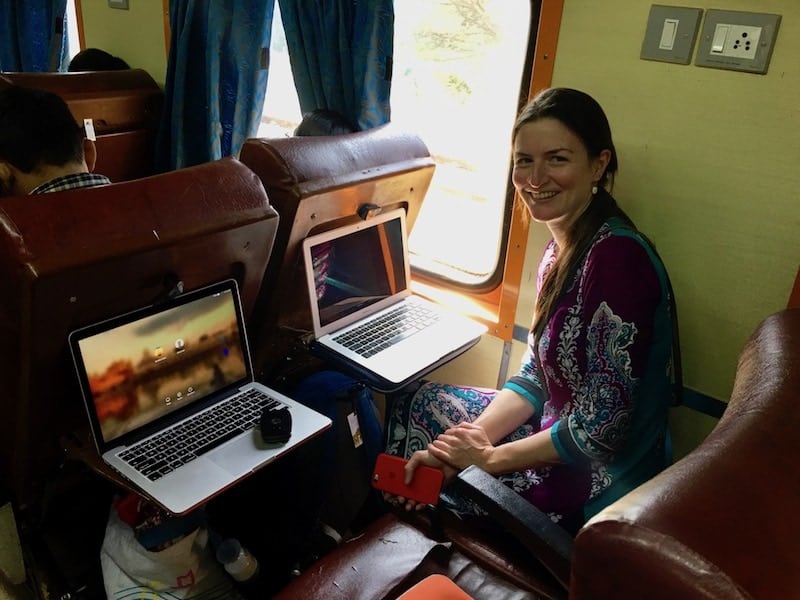
Sleeper (Non-AC Sleeper) mirrors the layout of 3AC but costs roughly a third of its price, albeit in much dirtier conditions. Windows are open, thus the coaches can actually heat up in summer and chill in winter. Bedding is not provided, so be sure to bring your own. Despite warnings about safety for foreigners, I’ve occasionally taken it for daytime journeys, but I would recommend avoiding sleeper class for overnight travel as it’s often best suited for photographing life as you pass.
Another reason for steering clear of (non-AC) sleeper class is that it is subsidized by the Indian government to keep costs low, catering to travelers who struggle to afford sleeper class for long-distance journeys. Sleeper class tends to be overcrowded, especially during peak travel times, so for these reasons, I recommend opting for a higher travel class whenever possible to leave room for those truly in need.
2nd Class & General Class: AVOID these unless you’re making a very short journey without any luggage and are keen on a backpacker experience. Their coaches have wooden benches, which may be tolerable during winter for short trips. I traveled in Goa and Kerala in 2nd Class for a couple of hours but wouldn’t risk longer journeys, especially in summer.
General class is unreserved and can be quite horrendous, especially in poorer regions like Uttar Pradesh. Anyone holding a Waitlist ticket is typically directed into General class, so please steer clear of this. (I’ve ventured into General class once on a one-hour trip, and let me tell you, those traveling there generally do not appreciate tourists—it can be quite congested!)
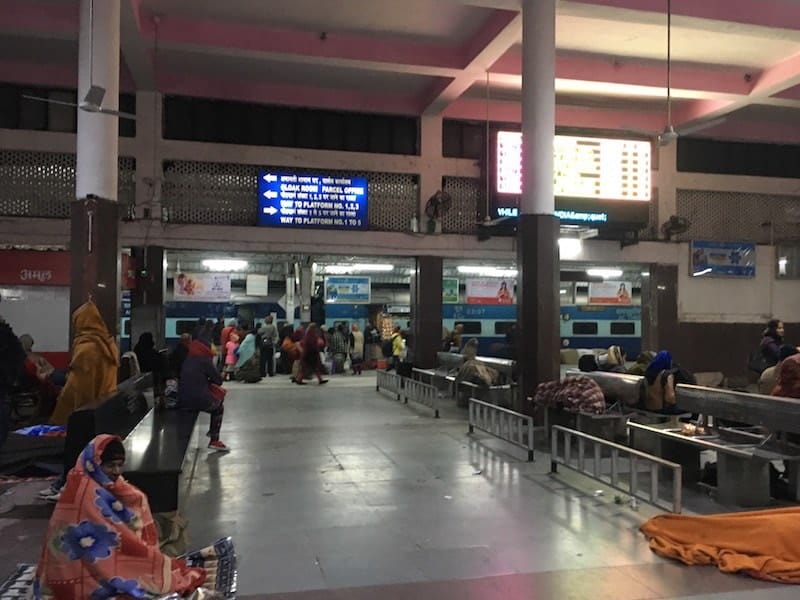
What to Do When Your Train is Full (and All Others are Too)
Don’t panic just yet. Options that don’t involve flying or taking a bus can help you score a train ticket when your desired train and all others appear fully booked.
Purchase a Tatkal Ticket
Tatkal is an emergency ticket service for immediate travel needs released at 10 AM the day before the train departs for AC Classes (11 AM for non-AC). Make sure you arrive ahead of time, as there will be a queue! You (or an agent) must be present before the opening time to claim your spot and fill out the required form. With some luck, you could acquire a ticket for your desired train, albeit at an extra 30% “Tatkal Premium.”
It used to be that Tatkal tickets could only be booked in person at the station, but I have successfully done this through Cleartrip several times, which has been incredibly helpful even if they end up being slightly pricier.
Book a Waitlist Ticket
Throughout my travels in India, I’ve had numerous waitlist tickets, many of which confirmed just hours before departure. Once a train is ‘full’ (meaning that regular non-Tatkal tickets have sold out), waitlist booking option opens. You can book a Waitlist ticket, but until it gets confirmed, it doesn’t guarantee a place on the train. Amongst the waitlist system, your status (from 1 up to several hundred) indicates your position in line based on the train’s popularity.
I’ve had great luck with waitlist bookings, occasionally securing confirmation even with a waitlist number of six or higher. I noticed last year that waitlists are growing longer as it appears more tickets are retained for Tatkal to enhance IRCTC’s revenue management.
Moreover, many spots aren’t released until the day of travel since confirmation depends on both cancellations and Tatkal ticket sales. Thus, a bit of uncertainty might linger with this option, making it wise to purchase a confirmed Tatkal ticket if you must travel on that day.
At the latest, you’ll find out your ticket’s confirmation status four hours prior to departure when the reservation charts are finalized.
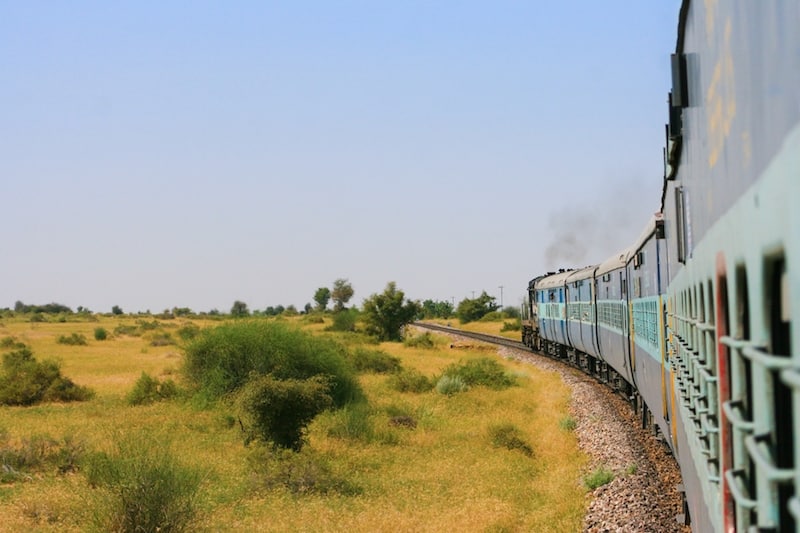
Boarding a Train with a Waitlist Ticket
If you have an RAC ticket, you can board the train. However, if you possess a Waitlist Ticket that isn’t confirmed, you are not permitted to board. Last year, though, we found ourselves needing to reach Goa on time!
After our tickets from Kerala to Goa remained unconfirmed, we contemplated our options. Since Tatkal for the following day had already closed, we decided our best option was to board the train anyway and negotiate once aboard (we bought a “General” ticket from the ticket office prior to boarding).
We had booked 2AC tickets, so we went to the 2AC compartment. As it was nighttime and we couldn’t locate the specific berths that were unoccupied, we waited in the vestibule for about an hour before our TC (Ticket Checker, dressed in a suit with a clipboard) showed up. Ravi explained our situation to him, and with some charm (highlighting that I was a confused foreigner), we were kindly given two agreeable berths in 2AC for the ride. Given that our original ticket was refunded, we settled the TC’s fee in cash, which was an amount lower than that spent on the original ticket. In most instances, you should expect to pay a little extra for this service (so negotiate!).
Would I recommend this approach? Not necessarily. If I had been traveling solo, I might have felt uncomfortable standing in the corridor with my luggage for an extended period, garnering some curious glances. You might also encounter less honest Ticket Checkers, who could demand a hefty fee since you technically boarded the train without the appropriate ticket for that class. However, if you desperately need to be somewhere and you’re willing to take a risk, this might be your best option! Rest assured, you are not depriving anyone of a seat since you will only receive a berth if one is available (hence there’s a slight chance you might find yourself standing!).
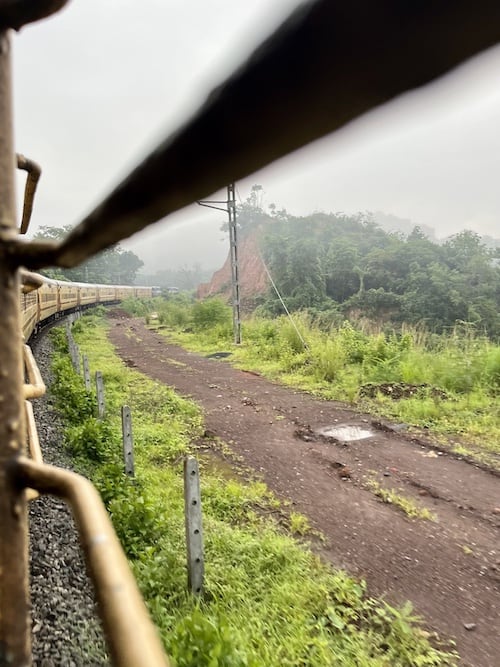
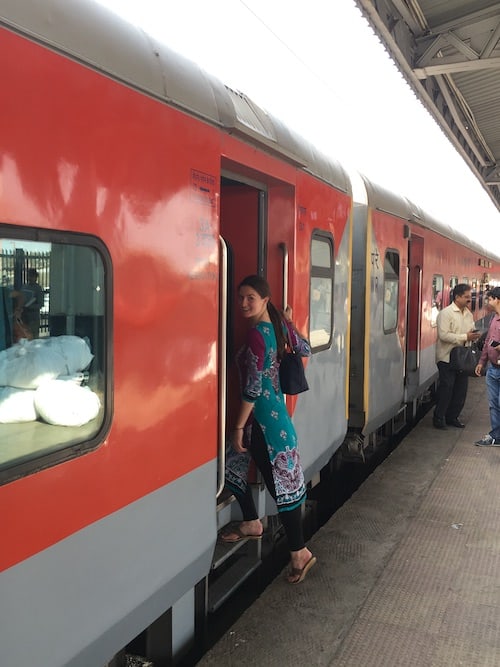
Get Creative with Your “From” Station!
While queuing up to buy a Tatkal ticket from Bikaner to Haridwar, a friendly local inquired about my destination. Suspecting he might direct me towards a travel agency, I shared anyway, and he suggested I didn’t need to pay extra for a Tatkal ticket—suggesting instead that I could buy a ticket from a little station named Luni (which is virtually in the middle of nowhere) before Bikaner, yet still gain access to a ticket to my destination.
Luni had limited foot traffic, yet due to quotas from each station along the route where a train halts, standard price tickets remained for sale as opposed to the elevated cost of Tatkal tickets. The ticket office processed this request without hesitation, and the ticket inspector onboard seemed quite content with this. You can only make purchases for a different “getting on point” in person.
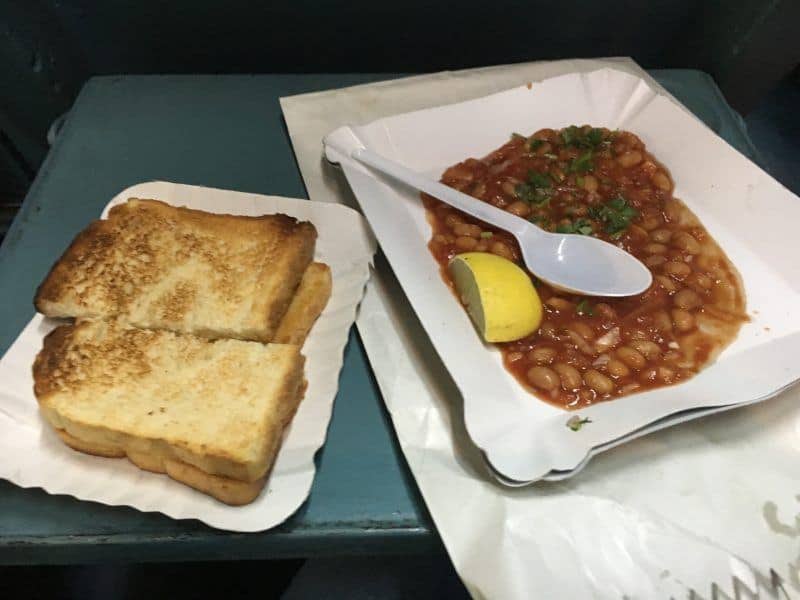
Safety Guidelines for Traveling on Indian Railways
One of the most common concerns for travelers inquiring about train trips in India is safety. The simple answer: YES!
The detailed answer: Train travel in India is generally safe, and most travelers enjoy positive experiences. Indian Railways has a commendable safety record, and police/guards are present on each train for assistance if required. The Railways Minister is also responsive on Twitter, reachable at @RailMinIndia.
Here are a few points to keep in mind to further enhance your travel safety:
- The main issues around rail travel often revolve around ticketing. Agents at New Delhi Railway Station may pose as the “official foreign tourist ticket office” (ignore them), and some touts often target tourists at platforms, claiming their train has been canceled or ticket is invalid, directing you to buy new tickets through them. Just disregard anyone who approaches you at stations—the official ticket checkers will walk through your train, and all passengers will typically show their tickets.
- Train travel is safe for solo women too! However, I recommend opting for the top bunk whenever possible for added privacy and protection while sleeping—avoid revealing sleepwear like shorts or tank tops.
- The doors frequently remain open during train journeys—ideal for views—but please exercise caution. As trains go fast and often run alongside poles on the track, don’t lean far out, especially while the train is moving—hold on securely if you decide to stand in the doorway.
- I’ve come across a lot of advice recommending that travelers bring a padlock and chain for their belongings, though I’ve personally never needed one. I make it a point to keep my small day pack on my upper bunk with me (it doubles as a pillow), while my larger bag goes beneath the seat. My cross-body purse with cash, passport, and phone remains on my person. However, if your bag contains valuables or you feel particularly concerned about theft, packing a padlock and chain is sensible—especially in non-AC sleeper where space can become crowded.
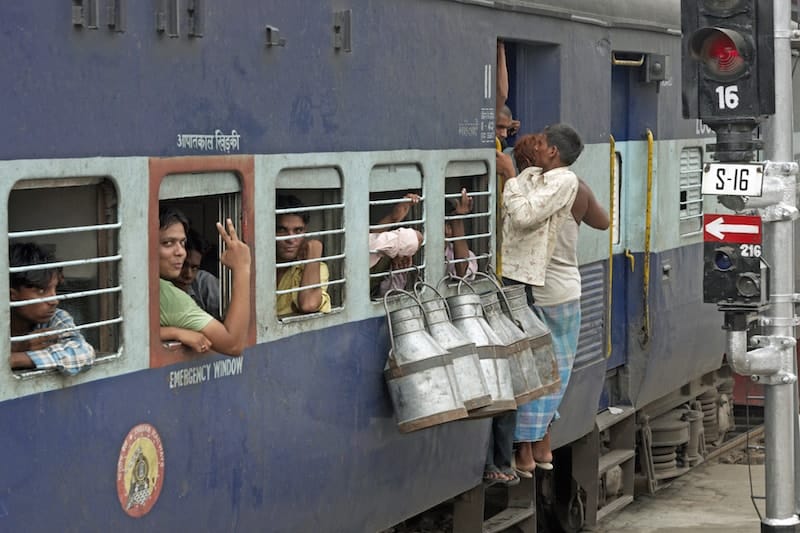
Debunking Myths about India Train Travel
Train travel in India garners considerable attention, which is hardly surprising! However, a few myths warrant dispelling:
- Not all Indian trains are late. It’s true that delays happen, but for me, those instances have been the exception rather than the standard. In general, when booking better quality trains and adhering to these guidelines, you’ll be unlikely to experience many late trains.
- People do not sit on the roofs of trains in India. This once occurred in the ’80s and ’90s, but nowadays, trains travel at fairly high speeds, making it practically impossible to ride atop!
- Not everyone you meet on Indian trains is out to take advantage of you. Plenty of articles caution against normal practices like leaving luggage unlocked, being overly vigilant, avoiding food, etc. While some misfortune has occurred, the overwhelming majority of train experiences are positive!
If you have an additional myth to add to our list, please share your India train tales in the comments below!
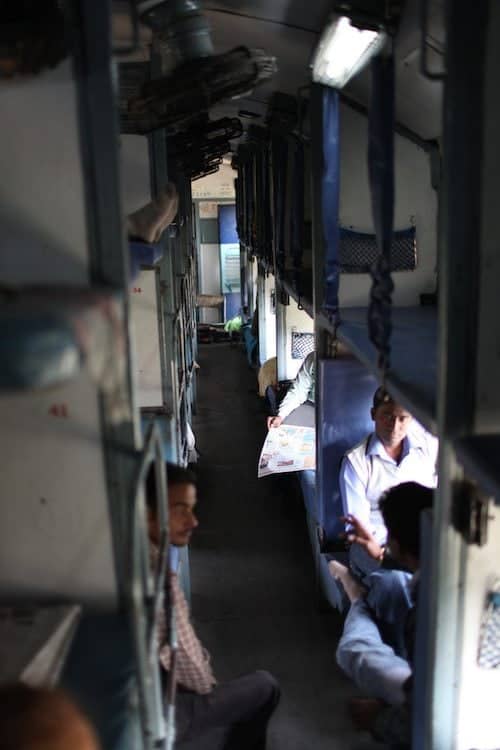
Packing Essentials for Train Travel in India
I recommend a handful of essential items that can significantly enhance your comfort during train journeys!
- Headphones. Sometimes you may just want some personal space—no need for fancy ones; your regular pair will suffice!
- An Eyemask – Since train lights often flicker on and off, this can help shield against disruptions, although personally, I prefer not to use one while solo traveling as I prefer to be aware of my surroundings.
- Hand Sanitizer – Toilets are often lacking soap, making this a vital item.
- A Sleeping Sheet / Sleeping Bag Liner – While sheets, pillows, and blankets are generally provided in AC classes, they may feel more comforting if you have your own. Most sheets are boiled after each journey, so they should be relatively clean.
- A Power Pack – Electric outlets can be scarce on overnight trains, resulting in fierce competition as passengers vie to charge their devices. Having a fully charged power pack ensures you don’t miss your stop’s alarm!
- A secure cross-body purse to keep your valuables (passport, phone, funds) close at all times.
- A good book! Internet and phone coverage can be patchy, and after a certain point, conversations may dwindle. Train journeys are an ideal time to catch up on some reading!
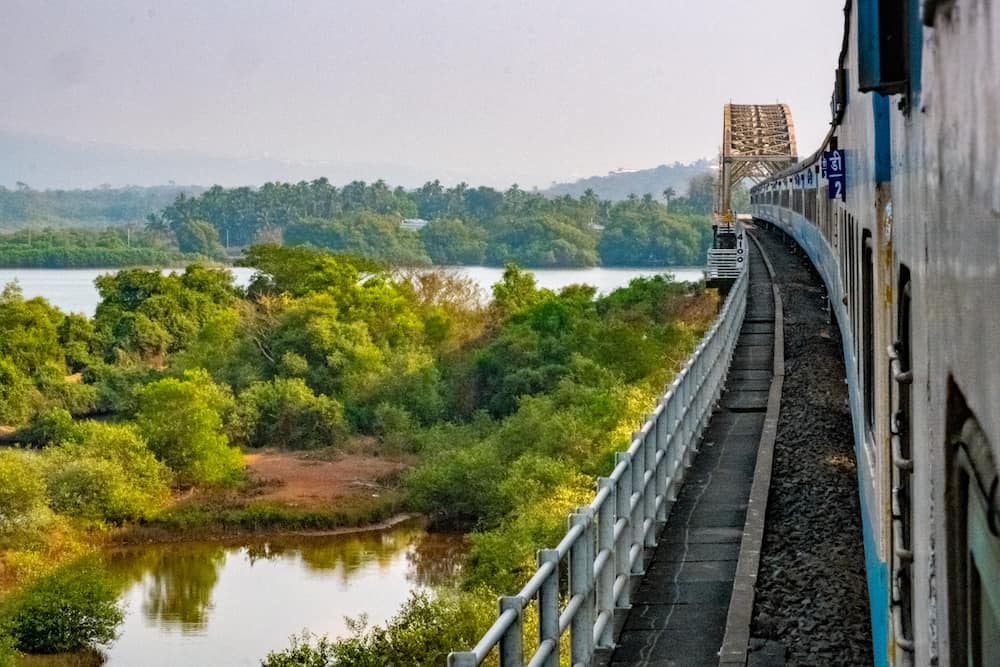
Additional India Train Travel Tips!
Food on Indian Trains – You can savor some delicious dishes while on Indian trains! Food vendors frequently get on and off the trains with regional specialties based on your route, although they can be unpredictably timed, making it wise to pack some snacks, too. Various chai wallahs might pass through quickly, only to vanish for hours. Additionally, some trains have dedicated pantry cars, and catering staff frequently move through the coaches selling food.
The finest chai and food is typically from vendors boarding at stations. Expect samosas in the North, vada pav from Maharashtra, idlis in the South, and, no matter where you are, plenty of the coveted ‘train biryani.’
Although many travelers hesitate to eat train food due to mixed guidance on its safety, personally, I’ve indulged numerous times without any stomach issues. If you’ve just arrived in India or have a sensitive stomach, you may want to take it easy and bring your provisions from a restaurant or hotel ahead of the journey.
You can now even have food delivered directly to your seat from nearby restaurants, providing a delightful dining experience!
Ensure You Wake Up for Your Stop!
Don’t expect the staff to wake you up at your destination—set an alarm in a spot where you can hear it. Be prepared to head for the door early if the train only stops briefly at a particular station.
The Indian (squat) toilets are usually cleaner…
Most coaches offer both “western” and Indian toilets. I usually lean toward the squat option as they tend to be cleaner! Western-style toilets often have evidence from previous users, making them less appealing. Toilet paper is rarely provided, so if you’re uncomfortable with water, be sure to pack tissues (remember, these are disposed of directly onto the tracks, so try using water if you can). I recommend bringing hand sanitizer or liquid soap as well, given that soap can be scarce or non-existent…
Stay informed about your ticket (and train) status.
Train punctuality is improving – the days of trains running up to 10 hours late (something I’ve witnessed) are fading. Fewer delays are primarily observed, often lasting an hour or two, typically due to winter fog in Northern India or monsoon rains in the South. You can check your train’s ‘running status’ on the relevant website. If it suggests that your train is approximately an hour late, it’s best to reach the station on time, as trains often recover lost time en route.
Plan the remainder of your journey.
Due to lengthy travels, trains frequently arrive or leave during the early hours of the morning or late at night. I highly recommend arranging transportation ahead of time to/from your hotel—especially for solo travelers, taking a rickshaw at night is not advisable. You can provide your train number to anyone picking you up for tracking purposes in case of delays.
Engage with your neighbors!
Some of my most cherished moments connecting with locals occurred on long train rides! There’s not much to do, and many locals are eager to engage with foreigners, often excited to practice their English. You’ll gain cultural insights while building new friendships through friendly conversation.
Remember, it’s about the journey, not just the destination.
In summary, if you travel by train in India, you’re bound to return home with tales to tell. Train travel may be hot, congested, and delayed, but it also offers a magnificent way to see this extraordinary land, connect with its people, and experience India’s charming contradictions. Relax, embrace spontaneity, and watch India’s vivid scenes unfold before you!
India Train Travel FAQ’s
Can I Book Train Tickets as a Foreigner Abroad? How?
Yes! There are several options available. You can either register for an IRCTC account with a foreign mobile number and purchase tickets directly there, or you can use a more straightforward option, which is to book them online directly here. 12Go offers the most popular routes in India and accepts foreign credit cards without the need to create an Indian Railways account. For full details, please refer to our “How to Book Tickets” section above in the guide.
What’s the Best Class to Travel on Indian Trains?
Your choice of class will depend on your budget, travel distance, and personal preference. However, we highly recommend 2AC (AC Two Tier) and 3AC (AC Three Tier) as the top choices for overnight journeys. For daytime express trains like Shatabdi Express, we suggest opting for Chair Car (CC), which is air-conditioned. For very short travel (less than 2 hours), 2S (Second Sitting) can suffice outside of summer. It’s advised to avoid non-AC classes for long-distance travel, especially if it’s your first visit to India.
Should I Try the Food on Indian Trains?
Many travelers (us included) have embraced the food on Indian trains, experiencing no consequential issues. Others, however, have reported getting sick or experiencing upset stomachs. If you’ve just arrived in India and haven’t adapted to the local cuisine yet, I recommend exercising caution and bringing your provisions from your hotel or a restaurant for the trip. Otherwise, dig in!
Is it True that Indian Railways are Always Late?
On my first visit to India, someone told me that the lateness of trains was measured not in hours but in quarters, halves, or full days! While it’s true that some trains are frequently delayed, I’ve discovered this to be the exception rather than the rule. Many trains run on time, especially higher-tier express trains. Fog in the winter months can trigger delays in Northern India, while heavy rains during monsoon season in the South play their part too. Always make sure to bring some extra food for your journey and allocate enough buffer time during your travel planning.
Is Train Travel in India Safe for Solo Women?
Women travel solo by train in India (including myself), and most report no issues whatsoever. I recommend that solo female travelers plan in advance to avoid arriving at new places during the middle of the night whenever possible and to secure an upper (top) bunk on trains. Women should consider traveling in 2AC or 3AC class instead of (Non-AC) sleeper. Wearing conservative attire also helps mitigate stares.
Have you traveled in India by train? Do you have additional tips to enrich this guide? Share your experiences with us in the comments below!
Are you planning solo female travel by train in India? Discover my safe train travel tips for women here!
Explore More About Traveling in India on Soul Travel:
First Time in India: Preparation and Expectations
Agra Travel Guide – Experience Agra Beyond the Taj
What to Wear in India
Pin this Post on Pinterest!
